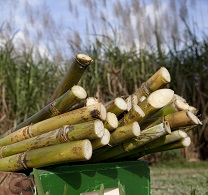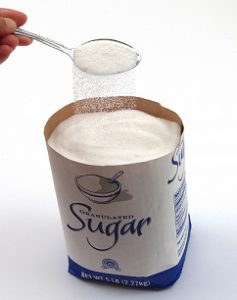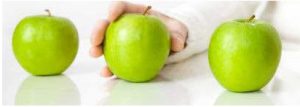By Samantha Walter-Cano, Edited by Yvonne Florian

With June being National Candy Month, let’s celebrate by learning how some candies are made and their nutrition facts. We will also talk about the history of candy making, and how to make some sweet treats at home.

History of Candy
Before the use of what we call sugar, the first “candies” were said to be made by using substances such as honey or fruit. While the history of sugar isn’t certain, there are accounts of sugar cane originating as a crop in New Guinea in 8,000 B.C. After that, sugar spread to southeast Asia and into Indian. It was there when the process of crystalizing sugar was developed. From there on, sugar spread to many different parts of the world.
First American Candy
The invention of caramel can be traced back to Arabia in 950 A.D. During the Middle Ages, candy became popular. However, sugar was so expensive it was only available for the wealthy. Though candy was brought to America in the 18th century from France and Britain, Native Americans did make candy by boiling maple sap till it crystalized into chunks of maple sugar candy.
Types of Candy
There are many different types of candy. From hard crack candy to jelly candy, all these candies are made differently. The ingredients used, the concentration of sugar, and the size of the sugar crystals determine the kind of candy that will be made. One of the most common ways to determine what the texture and kind of candy will be is by the several temperature stages. Cooking sugar syrup to different temperatures will give you these different stages:
Soft-Ball Stage:
Once the sugar syrup reaches a temperature of about 235° F, it is at the soft-ball stage. At soft ball, a thread will form in cold-water and it can be gathered into a ball between the fingers. However, the sugar will still be soft and is not at an adequate viscosity to hold its shape. It runs through the fingers. Soft gooey caramels, fudge, and fondant are some examples of candies made at this stage.
Firm-Ball Stage:
At a temperature of about 245° F, the syrup reaches the firm-ball stage. At this stage, the syrup has increased its viscosity enough to hold its own shape for a while. However, it can still be deformed by squeezing. Most caramels are typically cooked to the firm- ball stage.
Hard-Ball Stage:
At a temperature of about 250° F, the syrup will form thick threads that will form a hard ball. The concentration of sugar is higher at this stage, which allows it to maintain its shape. Although the ball is hard, you can still squash it and change its shape. Gummies, marshmallows, and nougat are examples of candies that are cooked to the hard-ball stage.
Soft-Crack Stage:
At this stage, at a temperature of about 270° F, the syrup’s moisture is low, and concentration is higher. This allows the syrup to form threads that are flexible and not brittle. The threads will bend slightly before finally breaking. Saltwater taffy and butterscotch are examples of candies cooked to this stage.
Hard-Crack Stage:
At a temperature of about 300° F, the highest candy stage temperature, the syrup is at the hard-crack Stage. At this stage, there is almost no moisture left. This stage is when hard, brittle threads form. They will break when bent. Examples of candies cooked to the Hard-Crack stage include toffee and lollipops.
Candy Nutrition
Though delicious, unfortunately, candy is just empty calories. Meaning candy is void of nutritional value. However, indulging in candy occasionally can be part of a healthy diet. The key to enjoying candy is moderation and responsibility. While it is true no candy is relatively healthy or “nutrient-dense”, there are lower-calorie candies to choose from. Examples are Werther’s Original Caramel Hard Candy and Tootsie pops. One Tootsie pop provides about 60 calories, and one Werther’s Carmel provides about 23 calories. Most gummies and hard candies are lower in calories than other candies.
However, the best alternative to candy is fruit. Fresh fruit contains fiber, vitamins, and natural sugars that may help satisfy your sweet tooth. It is important to remember that although candy isn’t all “healthy” for you, it’s okay to enjoy a small indulgence now and then.
Candy Recipes to Make at Home
Although the candy process seems difficult, don’t be discouraged! Candy making can become relatively easy with practice at home. The key is to be able to tell when you have reached the correct temperature for the specific candy you are making. A small candy thermometer is a must if you practice candy making at home. Here are some beginner candy recipes you can make and show off for special occasions.

Candied Citrus Peels
This fun, sweet treat can be made for any occasion. All you need are a few citrus peels, some sugar water and you have the perfect treat to take to a special event.
Recipe By: “Martha Stewart Living” magazine
Ingredients:
- 2 grapefruits, 3 oranges, or 4 lemons
- 4 cups sugar, plus more for rolling
- 4 cups water
Yield: Makes 2 1/2 cups
Directions:
- Step 1Using a paring knife, make 6 slits along curve from top to bottom of each citrus fruit, cutting through peel but not into fruit. Using your fingers, gently remove peel. Reserve fruit for another use. Slice each piece of peel lengthwise into 1/4-inch-wide strips. Using a paring knife, remove excess pith from each strip and discard.
- Place strips in a large saucepan, and cover with cold water. Bring to a boil, then drain. Repeat twice.
- Bring sugar and water to a boil, stirring occasionally until sugar dissolves. Stop stirring. Wash the sides of pan with a wet pastry brush to prevent sugar crystals from forming. Add strips to boiling syrup, reduce heat to medium-low, and simmer gently until strips are translucent, about 1 hour. Remove from heat, and let strips cool in syrup. (Strips in syrup will keep covered and refrigerated, for up to 3 weeks.)
- Using a slotted spoon, transfer strips to a wire rack placed on a rimmed baking sheet. Wipe off excess syrup with paper towels, then roll strips in sugar. Arrange in a single layer on a wire rack and let dry for at least 30 minutes.
Recipe Link: Candied Citrus Peels Recipe | Martha Stewart

Cran-Apple Jellies
This treat is perfect for use during the fall when these seasonal ingredients are available. When making this recipe, cook in a deep pot, and use a long whisk. For this recipe you will need a candy thermometer.
Recipe by: Alison Roman, “Bon Appetit” magazine

Ingredients:
- 1 large green apple, peeled, chopped
- 1-pound fresh (or frozen, thawed) cranberries
- 2 cups sugar, divided, plus more for coating
- 2 teaspoons pectin
- 1 tablespoon fresh lemon juice
- A candy thermometer
*Makes about sixty-four 1-inch jellies, 1 per serving
Directions:
- Line an 8”x 8” baking dish with parchment paper, leaving overhang on 2 sides. Purée apple, cranberries, 1½ cups sugar, and 1 cup water in a blender until smooth. Transfer to a large deep heavy pot fitted with thermometer and cook over medium heat, whisking occasionally, until mixture is very thick and bubbly (it will sputter and splatter as it cooks; reduce heat if needed), 8–10 minutes.
- Whisk pectin and remaining ½ cup sugar in a small bowl, then gradually whisk into cranberry mixture. Reduce heat to medium-low and continue to cook, whisking often, until the thermometer registers 200°, 15–20 minutes (mixture will be dark red and extremely thick).
- Whisk lemon juice into cranberry mixture, then scrape into the prepared pan; smooth top. Let cool until set (it should feel firm when you gently press it), at least 4 hours.
- Just before serving, unmold jelly onto a cutting board and cut into 1” squares. Toss jellies in sugar to coat.
- DO AHEAD: Jelly can be made 1 week ahead. Store in the pan, tightly wrapped, at room temperature. Cut and roll in sugar just before serving.
Recipe link: Cran-Apple Jellies Recipe | Bon Appétit (bonappetit.com)
If you would like to learn more about sweeteners, the University of Florida’s Institute of Food and Agricultural Sciences Electronic Data Information Source (UF/IFAS EDIS) has a publications titled, “Nutrition for Health and Fitness: Sugar and other Sweeteners” which may interest you.
Hartel, R. W., & Hartel, A. K. (2014). Candy bites: The Science of Sweets. Copernicus Books.
Zheng, A. (2019, February 25). How is candy made? The Scientific Teen. Retrieved October 24, 2022, from https://www.thescientificteen.org/post/how-is-candy-made
Types of candy. Candy Types – All Different Types of Sweets. (n.d.). Retrieved October 24, 2022, from http://www.candyhistory.net/candy-facts/candy-types/
Frey, M. (2020, October 30). Candy nutrition facts: Calories and carb counts. Verywell Fit. Retrieved October 24, 2022, from https://www.verywellfit.com/candy-nutrition-facts-calories-and-carb-counts-4117488
Science of cooking: Candy-making stages. Exploratorium. (n.d.). Retrieved October 24, 2022, from https://exploratorium.edu/cooking/candy/sugar-stages.html
Candied citrus peels recipe. Martha Stewart. (2020, December). Retrieved October 24, 2022, from https://www.marthastewart.com/313211/candied-citrus-peels
Roman, A. (2014, October 15). Cran-Apple Jellies. Bon Appétit. Retrieved October 24, 2022, from https://www.bonappetit.com/recipe/cran-apple-jellies
 3
3
